Trade & Generic Names
Ravuconazole (formerly BMS-207147 and ER-30346) is a triazole structurally related to fluconazole and voriconazole. It is being developed by Bristol-Myers Squibb for oral use. Its trade name has not been announced.

Mechanism(s) of Action
As with all azole antifungal agents, ravuconazole works principally by inhibition of cytochrome P450 14a-demethylase (P45014DM). This enzyme is in the sterol biosynthesis pathway that leads from lanosterol to ergosterol [2092]. The potency of ravuconazole to inhibit sterol C14 demethylation is similar to that of itraconazole [995].
Susceptibility Patterns
Ravuconazole is active against Candida spp., Cryptococcus neoformans, Aspergillus fumigatus, dermatophytes and dematiaceous fungi [785]. It is slightly less potent against Candida tropicalis, Candida glabrata, and Candida krusei that against other Candida spp, but it appears likely that it will be clincally active against all these species of Candida [785, 1783].
The activity of ravuconazole against Sporothrix schenckii, Pseudallescheria boydii, Fusarium spp., and fungi belonging to zygomycetes order is limited [785, 994].
For ravuconazole MICs obtained for various types of fungi, see susceptibility patterns and the N/A(L):susceptibility database.
Usual Doses
No data are available from Phase I and ongoing Phase II clinical trials. Typical doses are not yet known.
Side-Effects
Results of the clinical trials in men have not yet been reported.
No side effects have been noted in rats and dogs who have been treated with ravuconazole for a week [1614].
Routes
Ravuconazole has only been described as an oral formulation thus far.
Current Status
Ravuconazole is currently in Phase II clinical trials.
Unfortunately, the drug has not advanced as of yet to Phase III trials.
